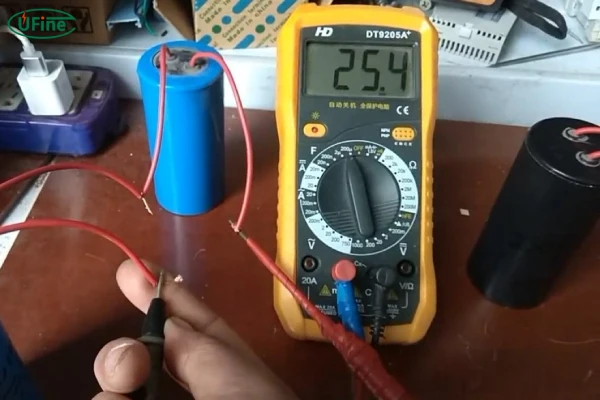
- Part 1. Prepare your tools
- Part 2. How to check the voltage of a lithium battery with a multimeter
- Part 3. How to check the current of a lithium battery with a multimeter
- Part 4. How to use a multimeter to check the internal resistance of a lithium battery
- Part 5. How to use a multimeter to check the capacity of a lithium battery
- Part 6. Is there an error in testing a lithium battery with a multimeter?
- Part 7. Safety tips for testing lithium batteries with a multimeter
- Part 8. Conclusion
Lithium batteries have become central to our lives, powering everything from our phones to power tools. Yet, like all batteries, they don’t last forever. Over time, lithium batteries lose capacity, impacting their performance. When this happens, it’s crucial to know if they still have life left, or if it’s time to replace them. This is where a multimeter—a tool that can measure voltage, current, resistance, and more—comes into play.
In this guide, I’ll walk you through each step in checking a lithium battery with a multimeter. Each test tells you something different about your battery’s condition, helping you assess whether it’s in good shape or on its last legs.
Part 1. Prepare your tools
Before jumping in, let’s make sure we have everything we need. Testing a battery might seem simple, but having the right setup can save you a lot of trouble and ensure accurate results.
Tools You’ll Need:
- Multimeter: This is your main tool. Make sure it has settings for DC voltage, current, and resistance. Digital multimeters are generally easier to use and more accurate than analog versions.
- Battery holder or connector: This helps secure the battery in place, especially when testing smaller or cylindrical batteries.
- Protective Gear: Lithium batteries can occasionally spark or leak, so gloves and safety goggles are always a good precaution.
- Notebook and pen: Keeping a record of each reading helps you track changes over time, which can reveal gradual declines in battery health.
Having everything ready before you start not only makes the process smoother, but it also reduces the risk of accidental short-circuiting or misplacing readings.
Part 2. How to check the voltage of a lithium battery with a multimeter
One of the simplest and most effective ways to gauge a lithium battery’s health is by measuring its voltage. Voltage essentially tells you how “full” the battery is at that moment.
Steps to Check Voltage:
- Set your multimeter to DC voltage mode. Look for a “V” symbol with a straight line on your multimeter’s dial.
- Adjust the range slightly higher than the battery’s nominal voltage. For example, set it to 10V if you’re testing a 3.7V battery.
- Connect the probes: Place the red probe on the positive terminal and the black probe on the negative terminal.
- Read the voltage displayed on the screen.
Interpreting the Voltage:
- A fully charged lithium battery (3.7V) should read between 4.1 and 4.2 volts when fully charged.
- If it reads significantly below its nominal value (e.g., below 3V), the battery may be too discharged, or it could be aging and losing its ability to hold a charge.
Voltage is often a quick indicator of battery health, but it’s not the only factor to consider. Batteries can sometimes maintain good voltage while having issues with current or capacity, which brings us to the next checks.
Part 3. How to check the current of a lithium battery with a multimeter
Current measurement is a bit more delicate. Checking current helps you understand how much power the battery can provide, which is essential if you’re using it in devices that require strong, consistent power.
Steps to Measure Current:
- Switch your multimeter to DC current mode, represented by an “A” symbol.
- Choose an appropriate range based on the battery’s capacity. If unsure, start at a higher range and adjust as needed.
- Disconnect the battery from any device.
- Place the red probe on the positive terminal and the black probe on the negative terminal.
- Observe the reading on your multimeter screen.
Important Note: Testing current directly can be risky, as it draws power directly from the battery. If you’re unsure about performing this test, it’s better to seek professional help or skip this step.
Understanding the Results:
A healthy lithium battery should deliver steady current in line with its rated capacity. If the reading is low or fluctuates, it could mean the battery is struggling under load, which often indicates it’s nearing the end of its lifespan.
Part 4. How to use a multimeter to check the internal resistance of a lithium battery
Internal resistance is like a battery’s hidden weak spot. High internal resistance can mean the battery is less efficient at delivering power, especially under load, making it a key factor in assessing battery health.
Steps to Check Internal Resistance:
- Set your multimeter to ohms (Ω) mode.
- Attach the probes: Place the red probe on the positive terminal and the black probe on the negative terminal.
- Read the internal resistance directly from the screen.
What the Resistance Tells You:
- Lower resistance indicates the battery is efficient at delivering power, which is a good sign.
- Higher resistance, especially if it’s climbing over time, usually points to aging or damage inside the battery. It’s a sign the battery might struggle in high-power applications or could overheat under heavy use.
Part 5. How to use a multimeter to check the capacity of a lithium battery
Capacity tells you how much charge a battery can hold—a critical factor if you’re relying on it for long usage periods. Checking capacity with a multimeter alone is a bit complex and often involves external tools, but here’s a basic approach.
Steps to Estimate Capacity:
- Fully charge the battery before testing.
- Set up a constant load that discharges the battery gradually. This could be a resistor or even a small device that draws a steady current.
- Monitor and record the discharge time. Connect the battery in series with the multimeter to measure the current drawn by the load.
- Calculate the capacity by multiplying the discharge current (in amps) by the time it took for the battery to reach its cutoff voltage.
Note: For a more accurate capacity test, a battery analyzer or specialized charger is preferable, as multimeters alone are not designed for precise capacity measurements.
Part 6. Is there an error in testing a lithium battery with a multimeter?
Testing lithium batteries with a multimeter is generally accurate, but errors can still occur. Here’s why and how to avoid them:
- Range Settings: Make sure the multimeter range is correctly set for each type of test. Setting the range too low or high can yield inaccurate results.
- Connection Quality: Ensure the probes are firmly connected to the battery terminals. Loose or shaky connections may result in fluctuating or incorrect readings.
- Temperature Factors: Cold batteries can yield lower-than-actual readings, while high temperatures can overstate readings. Test batteries at room temperature when possible.
These factors can impact accuracy, so double-checking and re-testing can help ensure consistent and reliable results.
Part 7. Safety tips for testing lithium batteries with a multimeter
Lithium batteries can sometimes be volatile, especially if they’re old or damaged. Follow these safety tips to minimize risks:
- Avoid Short Circuits: Keep the probes from touching each other when connected to the battery to prevent short circuits, which could cause sparks or damage.
- Wear Safety Gear: Gloves and safety glasses protect you from unexpected sparks or chemical leaks if the battery casing is damaged.
- Ventilate the Area: Lithium batteries can release gases if damaged, so working in a ventilated space is advisable.
- Keep Batteries Stable: If the battery starts to get warm during testing, stop immediately, as this can indicate instability.
By following these safety tips, you reduce the risk of accidents while testing your battery.
Part 8. Conclusion
Testing a lithium battery with a multimeter is a practical skill that gives you control over your battery health. With simple checks for voltage, current, internal resistance, and capacity, you can get a complete picture of the battery’s status. If you notice that the readings don’t align with healthy levels, it might be time to replace the battery or use it for lighter applications.
Keeping a record of your results over time can also help you spot gradual declines in performance, allowing you to stay ahead of any issues. With these steps and tips in hand, you’re well-prepared to make the most of your lithium batteries and ensure they remain reliable in your devices for as long as possible.
Related Tags:
More Articles

What is the Difference Between Silver Zinc Battery vs. Lithium-ion Rechargeable?
Compare silver zinc and lithium-ion rechargeable batteries: energy density, cycle life, safety, cost, and uses in drones, medical devices, EVs, and electronics.
What are Watts and Watt Hours in Battery?
Understand watt vs watt-hour in batteries: key differences, how to calculate capacity, and why they matter. Includes free comparison table.
Best 10 Blood Pressure Monitor Battery Review: Finding the Most Reliable
Are you looking for a reliable Blood Pressure Monitor battery? Here is a complete guide with the top 10 best blood pressure monitor batteries.
Bluetooth Headphone Battery Guide: All You Need to Know
Maximize headphone battery life with expert tips! Learn how to charge, check, troubleshoot, and choose the best bluetooth headphone battery in 2025.
LiFePO4 Battery VS. Lithium-ion Polymer Battery: Which One Is Best?
Comprehensive comparison of LiFePO4 vs Lithium Ion Polymer batteries: energy density, safety, lifespan, cost. Find out which battery suits your needs in 2025.



